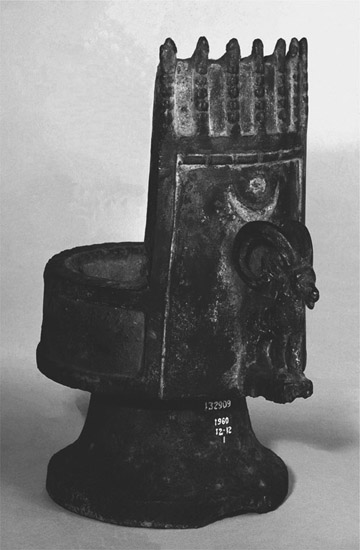
Frankincense and myrrh were aromatics highly prized and traded in ancient times. Shown here is a third-century B.C.E. bronze incense burner from Marib (in modern-day Yemen). (© The British Museum/Topham-HIP/The Image Works)
Key ancient trade items in the Mediterranean Sea and Indian Ocean areas derived from the resins of several species of trees belonging to the Burseraceae, or Balsam, family of plants, native to the southern Arabian Peninsula and the adjoining Horn of Africa.
The three species of Boswellia (Boswellia sacra, or B. carterii) native to the mountainous areas of Yemen and the Hadramawt (western Oman), are the principal historic source for high-quality frankincense. Myrrh trees (from the Arabic word for “bitter”) are more common than frankincense trees and belong to the Commiphora genus—Commiphora myrrha is the preferred source—that grow in southern Arabia, Ethiopia, and Somalia. East African myrrh has historically outweighed Arabian myrrh in exports.
Famous attempts were made in pharaonic Egypt to import the trees, as evidenced in the sculptures on Queen Hatshepsut’s tomb in the Valley of the Kings depicting an expedition to the land of Punt that returned with samples of plants, animals, and trees—including potted myrrh trees for her mortuary temple. Although the ancient Greek doctor Theophrastus records around 295 B.C.E. that a frankincense tree was successfully transplanted in the city of Sardes in Asia Minor—where he himself saw it growing—neither frankincense nor myrrh have been produced commercially outside of their native range. The cities of Yemen have traditionally been the seat of wholesale production and Egypt the center of worldwide distribution—in ancient times, this was apparently true of trade even to the East. Although the Red Sea and the Indian Ocean were common transport routes, inland Arabian kingdoms kept a stranglehold on supply in the ancient world through a network of land routes circumventing the Arabian Peninsula’s central deserts.
The ancient cultures of the Fertile Crescent used frankincense primarily as incense; myrrh was employed more extensively in ointments, unguents, perfumes, and medicines and in embalming Egyptian mummies. There is scholarly debate, however, whether Ethiopia or Arabia was the ancient source of Egyptian myrrh. The most accurate and firsthand description of the collection, production, and distribution of these two items in ancient times comes from the periplus of the Erythraean Sea, a Greek merchant’s description of Arabian and Indian Ocean trade written in the first or second century C.E. Pliny’s description of importation into Rome suggests production reached up to 3,000 tons of frankincense and 600 tons of myrrh in the first and second centuries C.E., coinciding with the introduction of epidemic diseases by way of the same trade network.

Frankincense and myrrh were aromatics highly prized and traded in ancient times. Shown here is a third-century B.C.E. bronze incense burner from Marib (in modern-day Yemen). (© The British Museum/Topham-HIP/The Image Works)
Frankincense’s value equaled that of gold in the markets of Rome, and the heavy transportation costs fueled economic development along the main trade arteries to the Mediterranean basin. Increasing demand during the Roman empire’s heyday encouraged Arabians to overcrop frank-incense and myrrh trees, degrading the sources. Early Christians, however, rejected the use of incense in worship because of its association with Greek and Roman polytheism, despite the famous gift of the Magi to the baby Jesus in the New Testament of frankincense, myrrh, and gold. Trade consequently decreased between the fifth and the seventh centuries, but picked up again when Muslim commerce expanded from the Atlantic to Asia and market demand increased as the Christian church accommodated ancient religious practices like incense burning into its rituals. Profuse amounts of frankincense were used in the medieval cathedrals, and myrrh continued to be a key ingredient in unguents, ointments, and medicines throughout the medieval period.
Commerce in frankincense and myrrh declined in the modern period as other plant materials and the development of synthetic sources supplanted the need for the original tree resins, though even at the beginning of World War I the city of Aden in Yemen was still annually exporting 1,000 tons of myrrh and substantial amounts of frankincense. Both substances have remained liturgically important in many faiths and are used in the perfume industry.
Fabio Lopez-Lazaro
See also: Perfume; Religion.
Groom, Nigel. Frankincense and Myrrh: A Study of the Arabian Incense Trade. New York: Longman, 1981.